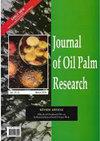油棕幼叶的内源性激素:对体外愈伤组织和胚胎诱导的反应
IF 1.3
4区 农林科学
Q2 Agricultural and Biological Sciences
引用次数: 0
摘要
油棕是一种生产植物油的植物。利用组织培养技术可以克隆生产出具有优良特性的优质油棕榈幼苗。外植体来源的选择非常重要,可以使用的外植体来源之一是年轻的油棕榈叶。胼胝体发生和胚胎发生的能力仍然很低,这被认为与内源性激素有关。本研究旨在鉴定油棕榈幼嫩无性系叶片外植体中内源激素的类型及其与愈伤组织和胚状体诱导的关系。选取6个油棕榈幼树的叶中肋骨作为外植体来源。提取外植体并使用高效液相色谱法分析内源激素含量。分析结果在四个油棕无性系中获得了各种类型的内源激素。在两个无性系中发现了玉米素激素ABA和IBA。在另外两个无性系中发现了9种激素,即不同浓度的玉米素、激动素、赤霉酸、IAA、BAP、ABA、IBA、2,4-二氯苯氧乙酸和萘乙酸。内源激素含量更完整的油棕榈幼叶有可能产生更多的胚性愈伤组织,并可以产生胚状体,以确保它们能够支持使用组织培养技术生产小植株。本文章由计算机程序翻译,如有差异,请以英文原文为准。
ENDOGENOUS HORMONES FROM THE YOUNG LEAVES OF OIL PALM (Elaeis guineensis Jacq.): A RESPONSE TO In Vitro CALLUS AND EMBRYOID INDUCTION
Oil palm is a plant that produces vegetable oil. Quality oil palm seedlings with superior characteristics can be produced clonally using tissue culture techniques. The selection of explant sources is very important, and one of the explant sources that can be used is the young oil palm leaves. The ability of callogenesis and embryogenesis remains low, and this is thought to be related to endogenous hormones. This study is aimed to identify the types of endogenous hormones in explants of young clonal oil palm leaves and their relationship to callus and embryoid induction. The leaf midribs of six young oil palms were selected as explant sources. Explants were extracted and analysed for endogenous hormone content using high-performance liquid chromatography. The results of the analysis obtained various types of endogenous hormones in four oil palm clones. Zeatin hormones, ABA and IBA were found in two clones. Nine hormones were found in the other two clones, namely zeatin, kinetin, gibberellic acid, IAA, BAP, ABA, IBA, 2,4-dichlorophenoxyacetic acid, and naphthalene acetic acid with various concentrations. Young oil palm leaves with a more complete content of endogenous hormones have the potential to produce embryogenic callus in greater numbers and can produce embryoids to ensure that they can support the production of plantlets using tissue culture technology.
求助全文
通过发布文献求助,成功后即可免费获取论文全文。
去求助
来源期刊

Journal of Oil Palm Research
农林科学-食品科技
CiteScore
2.60
自引率
30.80%
发文量
69
审稿时长
>12 weeks
期刊介绍:
JOURNAL OF OIL PALM RESEARCH, an international refereed journal, carries full-length original research papers and scientific review papers on various aspects of oil palm and palm oil and other palms. It also publishes short communications, letters to editor and reviews of relevant books. JOURNAL OF OIL PALM RESEARCH is published four times per year, i.e. March, June, September and December.
 求助内容:
求助内容: 应助结果提醒方式:
应助结果提醒方式:


